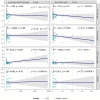Comparative analysis of contemporary anti-double stranded DNA antibody assays for systemic lupus erythematosus
- PMID: 38130723
- PMCID: PMC10733465
- DOI: 10.3389/fimmu.2023.1305865
Comparative analysis of contemporary anti-double stranded DNA antibody assays for systemic lupus erythematosus
Abstract
Objective: Elevated double-stranded DNA (dsDNA) antibody levels in blood serum are considered a disease-specific marker in systemic lupus erythematosus (SLE), correlate with disease activity and the incidence of lupus nephritis, and can be detected in up to 86% of all SLE cases. Despite the high clinical relevance, the variety of dsDNA antibody testing methods with heterogenous performance in clinical use remains challenging. This study is the first to prospectively investigate the performance of two of today's most commonly applied anti-dsDNA testing methods head-to-head under real-world conditions, as well as their correlation with other clinical and serological disease parameters in SLE patients.
Methods: In this prospective study, all SLE patients undergoing treatment at the Department of Rheumatology at the University Hospital Bonn within a 13-months period (n=41) and control patients without connective-tissue disease (n=51) were consecutively enrolled and examined. For all study participants' serum samples both anti-dsDNA-NcX enzyme-linked immunoassay testing EUROIMMUN, Luebeck, Germany) and the fluorescence immunoassay ELiA dsDNA (Thermo Fisher Scientific, Waltham, USA) were performed. In addition, demographic data, further laboratory values and disease activity parameters were recorded. Clinical disease activity was assessed by SLEDAI-2K.
Results: Both assays showed high specificity (anti-dsDNA-NcX ELISA: 0.9, ELiA dsDNA: 0.959), but there were notable differences in sensitivity (anti-dsDNA-NcX ELISA: 0.51, ELiA dsDNA: 0.38). Pearsons's correlation yielded a positive correlation between anti-dsDNA concentrations and CRP concentrations for the anti-dsDNA-NcX ELISA (R=0.22; p=0.038) and a mild-to-moderate inverse correlation between concentrations of anti-dsDNA and complement C4 for the ELiA dsDNA test (R=-0.22; p=0.045) when SLE and control patients were considered together. Other than, no significant correlation between anti-dsDNA concentrations and clinical or laboratory findings was found for either test procedure.
Conclusion: Both anti-dsDNA antibody assays represent reliable examination methods with high specificity for the diagnosis of SLE that fulfill EULAR/ACR requirements. However, the anti-dsDNA-NcX ELISA showed superior sensitivity and significant correlation with disease activity (as measured by CRP concentrations).
Keywords: SLE; autoimmune disorder; double-stranded DNA; dsDNA antibody; dsDNA antibody assay; dsDNA antibody test; immunology; systemic lupus erythematosus.
Copyright © 2023 Bauer, Karakostas, Weber, Behning, Stoffel-Wagner, Brossart, Dolscheid-Pommerich and Schäfer.
Conflict of interest statement
The authors declare that the research was conducted in the absence of any commercial or financial relationships that could be construed as a potential conflict of interest.
Figures



Similar articles
-
International multi-center evaluation of a novel chemiluminescence assay for the detection of anti-dsDNA antibodies.Lupus. 2016 Jul;25(8):864-72. doi: 10.1177/0961203316640917. Lupus. 2016. PMID: 27252263
-
Nonrenal and renal activity of systemic lupus erythematosus: a comparison of two anti-C1q and five anti-dsDNA assays and complement C3 and C4.Rheumatol Int. 2012 Aug;32(8):2445-51. doi: 10.1007/s00296-011-1962-3. Epub 2011 Jun 26. Rheumatol Int. 2012. PMID: 21706294
-
Anti-dsDNA-NcX ELISA: dsDNA-loaded nucleosomes improve diagnosis and monitoring of disease activity in systemic lupus erythematosus.Arthritis Res Ther. 2011 Feb 10;13(1):R26. doi: 10.1186/ar3250. Arthritis Res Ther. 2011. PMID: 21329504 Free PMC article.
-
The use of laboratory tests in the diagnosis of SLE.J Clin Pathol. 2000 Jun;53(6):424-32. doi: 10.1136/jcp.53.6.424. J Clin Pathol. 2000. PMID: 10911799 Free PMC article. Review.
-
Anti-dsDNA Testing Specificity for Systemic Lupus Erythematosus: A Systematic Review.J Appl Lab Med. 2022 Jan 5;7(1):221-239. doi: 10.1093/jalm/jfab146. J Appl Lab Med. 2022. PMID: 34996090
Cited by
-
Comparative evaluation of three anti-dsDNA antibody detection methods in systemic lupus erythematosus: insights from a large monocentric cohort.Front Immunol. 2025 Apr 10;16:1529484. doi: 10.3389/fimmu.2025.1529484. eCollection 2025. Front Immunol. 2025. PMID: 40276498 Free PMC article.
-
Exploring the role of APRIL in autoimmunity: implications for therapeutic targeting in systemic lupus erythematosus, rheumatoid arthritis, and Sjögren's syndrome.Front Immunol. 2025 Aug 1;16:1523392. doi: 10.3389/fimmu.2025.1523392. eCollection 2025. Front Immunol. 2025. PMID: 40821822 Free PMC article. Review.
-
Effects of environmentally-induced anxiety on autoimmunity in the MRL/lpr mouse.Lupus Sci Med. 2025 Jun 19;12(1):e001528. doi: 10.1136/lupus-2025-001528. Lupus Sci Med. 2025. PMID: 40541270 Free PMC article.
References
Publication types
MeSH terms
Substances
LinkOut - more resources
Full Text Sources
Medical
Research Materials
Miscellaneous

